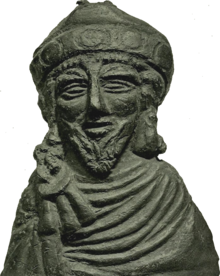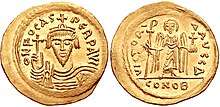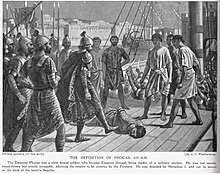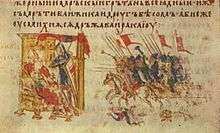Phocas
Flavius Phocas (Greek: Φωκᾶς; c. 547 – 5 October 610) was Byzantine emperor from 602 to 610. The early life of Phocas is largely unknown, but he rose to prominence in 602, as a leader in the revolt against Emperor Maurice. Phocas captured Constantinople and overthrew Maurice on 23 November 602, and declared himself emperor on the same day. Phocas deeply mistrusted the elite of Constantinople, and therefore installed his relatives in high military positions, and brutally purged his opponents. Phocas was an incompetent leader, both of the administration and army, and under him the Byzantine Empire was threatened by multiple enemies, with frequent raids in the Balkans from the Avars and Slavs, and a Sassanid invasion of the eastern provinces. Because of Phocas' incompetence and brutality, the Exarch of Africa, Heraclius the Elder, rebelled against him. Heraclius the Elder's son, Heraclius, succeeded in taking Constantinople on 5 October 610, and executed Phocas on the same day, before declaring himself the emperor.
| Phocas | |||||||||
|---|---|---|---|---|---|---|---|---|---|
| Augustus | |||||||||
 7th century bronze steelyard-weight housed at the British Museum, probably representing Emperor Phocas | |||||||||
| Emperor of the Byzantine Empire | |||||||||
| Reign | 23 November 602 – 5 October 610 | ||||||||
| Predecessor | Maurice and Theodosius | ||||||||
| Successor | Heraclius | ||||||||
| Died | 5 October 610 Constantinople | ||||||||
| Spouse | Leontia | ||||||||
| Issue | Domentzia | ||||||||
| |||||||||
| Mother | Domentzia | ||||||||

Life
Early Life
Flavius Phocas' date of birth is unknown.[1] He and his family were likely of Thraco-Roman origin.[2] The life of Phocas before his usurpation of the Byzantine Empire's throne is obscure, but it is known that he served as a low-ranking officer under Emperor Maurice.
Usurpation
In 602, the Byzantine army rebelled against Emperor Maurice, largely due to exhaustion and outrage over orders to continue campaigning north of the Danube in winter as well as previous cuts in wages. The army declared Phocas, by then a centurion, to be the new emperor, raising him on a shield (the traditional method of declaring emperors) on 23 November 602.[3][4]
Phocas was crowned the new emperor by the patriarch in the church of St John the Baptist at the Hebdomon. Several days afterwards he entered Constantinople unopposed.
Maurice fled the city with his sons, Theodosius and Tiberius, but they were soon after captured and executed. Maurice's wife and daughters were put in the monastery of Nea Metanoia and later killed.[5]
Foreign conflict
Despite the execution of the previous emperor and his dynastic successors, Phocas remained in a precarious position, which led him to devote his energy to purging enemies and destroying conspiracies. Because of this focus, and the local resistance he faced all throughout the Byzantine Empire, he was unable to confront foreign attacks on the empire's frontiers. The Avars and Slavs launched numerous raids into the Balkan provinces of the Byzantine Empire, and the Sassanian Empire launched an invasion of the eastern provinces of the empire.
The Avars were able to take all land in the Balkans north of Thessalonika. The populations of Christian cities were slaughtered or captured. The Byzantines transferred most of their forces to the eastern front due to the threat from the Persians.
The Sassanid Persians had formerly been at peace with Maurice as a result of a treaty they made with him in 591. After Phocas usurped and killed Maurice, the Persians invaded the empire in 603. [3] The Sassanids rapidly occupied the eastern provinces, leading the Magister militum per Orientem, Narses, to defect to their side. Phocas swiftly dealt with him, by inviting him to Constantinople under the promise of safe conduct, then having him burnt alive when he arrived. By 607, the Sassanids had occupied Mesopotamia, Syria, and much of Asia Minor, as far as the Bosphorus.[6]
By the time his reign ended in 610, the Persians had already crossed the Euphrates and taken Zenobia. Contemporary accounts describe the Persians as being very brutal to the occupied population. The 'miracle of St Demetrios' described the carnage:
[T]he devil raised the whirlwind of hatred in all the East, Cilicia, Asia, Palestine and all the lands from there to Constantinople: the factions, no longer content simply to spill blood in public places, attacked homes, slaughtered women, children, the aged, and the young who were sick; those whose youth and frailty impeded their escape from the massacre, [saw] their friends, acquaintances, and parents pillaged, and after all that, even set on fire so that the most wretched inhabitant was not able to escape.[5]
Administration
Phocas was an incompetent administrator, who was unable to control either the state or the army effectively.[7] Due to his distrust of the bulk of Constantinople's elite, with whom he had no connection before becoming emperor, Phocas practised nepotism, frequently filling senior military positions with his relatives. He installed: his brother Domentziolus as Magister officiorum in 603; his nephew Domentziolus as Magister militum per Orientem in 604, giving him command over the eastern provinces; and his brother Comentiolus as Magister militum per Orientem around 610. All three remained loyal to Phocas until they were killed by Heraclius.[8] Of the three known male blood-relatives of Phocas, all three were appointed to senior posts, two in military positions and one in an administrative position. Phocas also appointed Priscus, who was his son-in-law by way of his marriage to Phocas' daughter Domentzia, as Comes excubitorum, the captain of the Excubitors, in 603.[9]
Italian policy
When Phocas was Emperor, Byzantine Italy was under continual attack from Lombards, but the Byzantine government spent few resources to aid Italy due to troubles elsewhere. In the entirety of Phocas' reign the only public building built with government money in the city of Rome was a statue of Phocas completed in 608.[5]
When Phocas usurped Maurice, Gregory the Great was bishop of Rome and he praised Phocas as a restorer of liberty. Gregory referred to him as a pious and clement lord, and compared his wife (the new Empress) Leontia to Marcian's consort Pulcheria (whom the Council of Chalcedon called the new Helena). In May 603, portraits of the imperial couple arrived in Rome and were ordered by the pope to be placed in the oratory of St Caesarius in the imperial palace on the Palatine.[5]

Imperial approval was needed in that time to appoint a new pope, but the approval was delayed by a year upon the death of Pope Sabinian in 606, as Phocas was occupied with killing internal enemies that threatened his rule.[5] He finally gave approval in 607 and Boniface III became pope. Phocas declared Rome "the head of all churches".[5] Shortly afterwards, Phocas had a gilded statue of himself erected on a monumental column in the Roman Forum, known as the Column of Phocas.

Downfall
Despite being appointed as Comes excubitorum, Priscus was not loyal to Phocas, and in 608 he appealed to Heraclius the Elder, the Exarch of Carthage, to rebel against Phocas.[9] Heraclius the Elder agreed, and began to prepare to invade, by cutting off the supply of grain to Constantinople and assembling a large army and navy. Heraclius the Elder launched his invasion in 609, with his cousin, Nicetas, marching troops overland to the capital, and his son, Heraclius, leading a naval invasion of Thessaloniki, before marching to Constantinople. Heraclius arrived outside Constantinople on 3 October 610, and seized the city on 5 October. Heraclius was declared emperor on the same day, and swiftly had Phocas executed.[10]
Legacy
Phocas is generally depicted as a villain by Byzantine and modern historians alike, but some of the earliest sources available about Phocas’ reign were written during the reign of Heraclius. The writings that survive aren’t reliably neutral and the writers would have good reason to demonize him in order to strengthen the rule of Heraclius.[11]
In the cultural sphere, the reign of Phocas is marked by the change of Imperial fashion set by Constantine the Great. Constantine and all his successors, except Julian the Apostate, were beardless. Phocas again introduced the wearing of the beard. This fashion lasted until the end of the Byzantine Empire.[12]
In calling the Pope the "head of all churches", Phocas' decree has been important in discussions about papal primacy and papal supremacy. Some Protestant historicist commentators have seen the decree of Phocas (usually taken to be in 606) as having eschatological significance.[13] For example, in his Horae Apocalypticae, Edward Bishop Elliott took the 1260 days of Revelation 11:3 to be the period between 606 and the Unification of Italy in 1866.
References
- Crawford 2013, p. 27.
- Bury, John Bagnell (2009) [1889]. History of the Later Roman Empire from Arcadius to Irene. II. Cosimo, Inc. ISBN 1-60520-405-6.
- Kleinhenz 2017, p. 890.
- Carr 2015, p. 79.
- Ekonomou, Andrew. Byzantine Rome and the Greek Popes. Lexington books, 2007
- Carr 2015, p. 80.
- Parnell 2016, p. 6.
- Parnell 2016, p. 136.
- Parnell 2016, p. 137.
- Carr 2015, p. 81.
- Kevin, Crow (2002). "Phocas". De Imperatoribus Romanis. Retrieved 25 September 2019.
- "Byzantine first & last times". Byzantium.xronikon.com. Retrieved 7 November 2012.
- Newsom, Carol A. (2014). Daniel: A Commentary. Westminster John Knox Press. p. 317. Retrieved 8 July 2020.
Bibliography
- Carr, John (2015). Fighting Emperors of Byzantium. Pen and Sword. ISBN 9781473856400.CS1 maint: ref=harv (link)
- Crawford, Peter (2013). The War of the Three Gods: Romans, Persians and the Rise of Islam. Pen and Sword. ISBN 9781473829510.CS1 maint: ref=harv (link)
- Kleinhenz, Christopher (2017). Routledge Revivals: Medieval Italy (2004): An Encyclopedia. Taylor & Francis. ISBN 9781351664431.CS1 maint: ref=harv (link)
- Parnell, David Alan (2016). Justinian's Men: Careers and Relationships of Byzantine Army Officers, 518-610. Springer. ISBN 9781137562043.CS1 maint: ref=harv (link)
External links
![]()
Phocas Non-dynastic Born: unknown Died: 610 | ||
| Regnal titles | ||
|---|---|---|
| Preceded by Maurice |
Byzantine Emperor 602–610 |
Succeeded by Heraclius |
| Preceded by Lapsed; no consuls from 583 to 603 |
Consul of the Roman Empire 603 |
Succeeded by Lapsed; no consuls appointed until Heraclius the Elder and Heraclius were appointed in 608 |